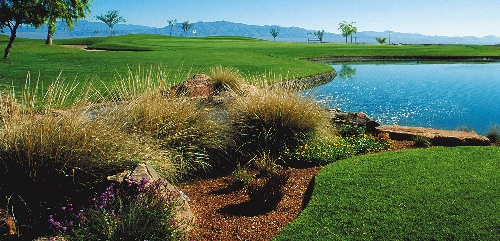Angel Park’s secret: Strong enough for a man, but made for a woman

Although for a long time golf was predominantly considered an opportunity for primitive man — with a club in his hands, no less — to escape the cave for half a day and engage in the ultimate form of masochism, times have changed. Today, it is remarkable to see not just the large number of women enjoying the game, but the number of couples playing together.
One of the main impediments to togetherness on the links has been the token effort many golf course architects have put into placing the forward tee box, a flaw amplified by today’s risk-reward designs. Although women at the highest levels of golf can absolutely crush the ball — hitting hybrids farther than this midhandicapper can hit a driver — the slower swing speeds associated with less accomplished female players tends to bring into play an unreasonable number of forced carries. It isn’t that triple-digit golfers of the male persuasion are any more talented; they just generally hit the ball farther.
Angel Park Golf Course, a perennial Las Vegas Review-Journal Reader’s Poll winner, clearly recognized the difficulties faced by people with slower swings when creating the Palm course, one of two 18-hole tracks at the sprawling golf complex. Touted by Golf Digest as one of “America’s Top 50 Courses for Women,” Angel Park’s Palm track isn’t just shorter from the red tees; it is an entirely different layout.
The opening hole exemplifies that point. A 447-yard par 4 that doglegs left nearly 90 degrees from the tips, No. 1 plays almost straightaway from the 321-yard red tees. Some guys may be irked to find themselves hitting first from the fairway, but it is important to consider that, according to several golf-oriented websites, the average amateur woman hits the same club 40-50 yards shorter than her male counterpart. With no trouble save a bunker well right of the green, the opening hole represents a relatively easy par.
For those who may be crossing this course off their playlist thinking that it won’t challenge longer hitters, think again. From the tips, this par-70 track runs an even 6,500 yards with trouble on virtually every hole. It isn’t that the Palm is a pushover; rather, the course’s designer took into consideration the fact that players of varying skill and strength might want to play together.
While the ladies catch another break at the short par 4 fourth hole — which requires a forced carry from every tee set except the front — it’s go-time at No. 5, a par 3 that requires players to carry a wide lake that laps at the green’s front edge. Playing 186 yards from the back and about half that from the red tees, this hole’s broad green is forgiving in terms of accuracy but not distance. Landing on the wrong tier of this split-level putting surface, however, will make for an interesting two-putt.
Heading into the turn, players face a very short but not realistically drivable par 4 that takes strokes as easily as it dispenses them. With a massive lake running along the fairway’s left edge and eliminating any reasonable chance of reaching the green, most place a hybrid or fairway wood just inside the two bunkers bordering the right side. From there, the water is less of a factor on the short approach, although it can still swallow any careless iron shots that stray left.
After a very long, difficult par 4 to start the road home, patience is rewarded at No. 11, a 511-yard boomerang-shaped par 5. While everyone must carry desert with their drive, the distance from the red set is significantly less than from the back. The most aggressive line is directly over the small pines that stand guard at the fairway’s left edge; a successful shot is rewarded with an opportunity to reach the green in two. Even for those who take the more traditional route, the wedge approach to a defenseless putting surface is stress-free.
The second of two short par 4s, No. 16 is substantially more difficult than its counterpart because of a much narrower fairway and the presence of a small but magnetic bunker along the right edge that seems to draw every loose shot. The elevated green makes it difficult to judge the pin placement, so players have little choice but to trust the yardage. A deep bunker protects the front right portion of the green, but most other misses are recoverable.
Angel Park’s Palm course closes with a birdie opportunity in the form of a short par 4. Although a waste area runs almost its entire length along the right side, even a shot from there is not unreasonable. The better choice, however, is to play just inside the knob jutting in from the left, which sets up a much better angle to the diagonally oriented putting surface.
With four tee boxes ranging from the 4,578-yard forward set to the 6,500-yard tips, this track offers as little or as much challenge as players care to bite off. Anyone still lamenting the loss of “man time” should take consolation in the many extra guilt-free rounds they will now get to enjoy in the company of their better half.
Angel Park Golf Club is located at 100 S. Rampart Blvd., just south of the Summerlin Parkway. For more information or to reserve a tee time, visit www.angelpark.com or call 254-4653.